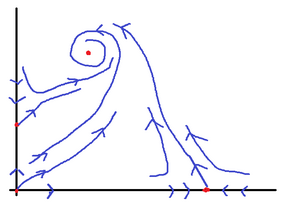Science:Math Exam Resources/Courses/MATH215/December 2013/Question 06 (b)
{{#incat:MER QGQ flag|{{#incat:MER QGH flag|{{#incat:MER QGS flag|}}}}}}
• Q1 (a) • Q1 (b) • Q1 (c) • Q1 (d) • Q1 (e) • Q1 (f) • Q2 (a) • Q2 (b) • Q3 (a) • Q3 (b) • Q4 (a) • Q4 (b) • Q4 (c) • Q5 (a) • Q5 (b) • Q6 (a) • Q6 (b) • Q6 (c) • Q7 (a) • Q7 (b) • Q7 (c) •
Question 06 (b) |
|---|
|
Suppose the interaction between two species ( is the “prey” while is the predator) can be modelled by the autonomous system: (b) Sketch a phase portrait for the nonlinear system by first sketching a few trajectories near each critical point. |
|
Make sure you understand the problem fully: What is the question asking you to do? Are there specific conditions or constraints that you should take note of? How will you know if your answer is correct from your work only? Can you rephrase the question in your own words in a way that makes sense to you? |
|
If you are stuck, check the hint below. Consider it for a while. Does it give you a new idea on how to approach the problem? If so, try it! |
Hint |
|---|
|
To find some characteristic trajectories near each critical point, you'll need to compute the eigenvectors of the linearized systems - this will tell you what direction the trajectories move. |
|
Checking a solution serves two purposes: helping you if, after having used the hint, you still are stuck on the problem; or if you have solved the problem and would like to check your work.
|
Solution |
|---|
|
We will need to analyze the linearized system at each critical point.
At (x,y) = (0,0)which has eigenvectors and with corresponding eigenvalues 3 and 1 respectively. The local solution structure centred at (0,0) is Along both eigenvectors, the trajectories move away, with the direction being dominant, since it is multiplied by the larger term, e3t.
At (x,y) = (0,1)To find the eigenvector corresponding to , we seek the solution to so that Or , so we take . To find the eigenvector corresponding to , we seek the solution to so that Or v1 = 0, v2 = anything, so we take . The local solution structure centred at (0,1) is The solution grows exponentially along the direction and decays exponentially along the direction. Starting anywhere other than along the vector, the solution will approach the vector.
At (x,y) = (3,0)To find the eigenvector corresponding to , we seek the solution to so that Or v2 = 0, v1 = anything, so we take . To find the eigenvector corresponding to , we seek the solution to so that Or , so we take . The local solution structure centred at (3,0) is The solution grows exponentially along the direction and decays exponentially along the direction. Starting anywhere other than along the vector, the solution will approach the vector.
At (x,y) = (1,2)
which points up and to the left at (1,0). Therefore the spiral is counterclockwise. This is all put together in the very rough global phase portrait. |
{{#incat:MER CT flag||
}}


































